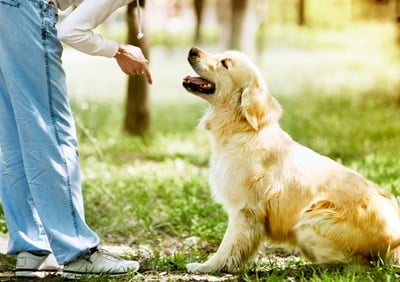One of the most important steps when you being training a dog is being able to correctly communicate your intentions to him. Letting him know when he’s doing things right and, of course, knowing how to correct him when he isn’t.
There are many different dog training techniques, all of which are equally good and effective. But there are just a few correct techniques to let your dog know that you aren’t happy with his behavior or simply get his attention. Let’s review and explain the right way to say “no” to your dog.

How to correct a dog’s behavior: When should you correct him?
The most important thing when it comes to training an adult dog or puppy is the common sense of the one doing the training. It’s pointless to spend a thousand hours training your adult dog or puppy if you don’t do it correctly. And one of the most common mistakes is correcting or scolding the dog at the wrong time.
If you want to scold your dog for something he did wrong, you should do it right when he is doing it, not before and not after. For example, some people, when they get home and see that their dog has broken something or done something bad, they scold him or even hit him (something that you should never, ever do), thus committing a huge error.
Dogs aren’t mind readers and they don’t have the ability to relate what they’ve done in the recent past with the present. That’s why, if you want to correct your dog’s behavior or get his attention, you have to do it right when he’s breaking the object or behaving badly.
It’s pointless to do it afterwards, hours later when you get home and see that something’s broken, because your dog won’t understand that the reason you’re scolding him is for having broken something before. And sure, we all know that when we scold them, they give us those puppy dog eyes that say “I’m sorry, it won’t happen again”, but in reality they have no idea why you’re scolding them.
Whether you want to scold him or just correct him or get his attention a bit, you should always do it in the exact moment it’s happening.

How to correct a dog’s behavior: The “tug” or “pinch”
Now getting to how we will let the dog know that he’s doing something wrong, or the best ways to correct a dog or puppy. First we’ll explain the “tug” and “nip”, which you’ve most likely seen on an episode of the famous program, The Dog Whisperer.
This technique is undoubtedly one of the most effective ones, and at the same time respectful. It’s critical to understand that you should never, under any circumstances, hit your dog (or any other dog, obviously). Aggression is not a training technique; assaulting a dog is simply an act of complete ignorance and cowardice.
When correcting your dog, you can use two options, always accompanied by a vocal correction. You should choose a good sound to use when correcting your dog and use it every time you want to let your dog know that you’re correcting his behavior.
Some people use “SSSHHHhhh!” and others use “No!”. Both are equally good, just choose the one that you like best. The options that you can use along with the vocal signal that you choose is the “gentle leash tug” or “hand nip”.
The gentle leash tug is just that: when your dog is doing something bad and you happen to have him on the leash, you give him a gentle, sharp tug while telling him “No!” (or “SSSHHHhhh!”, whichever you prefer). Remember that it should be a gentle tug, it isn’t meant to hurt him. In the video above, you can see how Cesar does this tug (there are some who agree and some who disagree with Cesar’s techniques, but this technique specifically is very good).
The hand nip is another technique that you can use along with the gentle leash tug or independently, but always accompanied by the vocal “No!” or “SSSHHHhhh!”. It involves giving a small pinch with your hand on your dog’s back, without hurting him, just a nip to get his attention.
Simply keep your hand straight and give him a gentle nip or pinch. It should be soft, not rough, because the goal is to get your dog’s attention, to correct him, not to hurt him. Here’s another example of Cesar, with the pinch technique.
As you can see, it’s very simple and respectful. It doesn’t hurt the dog, you should never hurt him, just give him a little poke to correct him, that’s all.
Obviously, these techniques work well in adult dogs (1 year or older), but in puppies or young dogs you need to have lots, and I mean lots of patience. On the other hand, there are many dogs who respond to a simple “No!” and you don’t have to use the “nip”, you just need to use the techniques that you feel are necessary.

How to correct a dog’s behavior: The trainer
Even more important than trying to train your dog, is knowing the correct way to do it, because if he learns to do something wrong, it will be more complicated to teach him the right way later.
You should remain calm at all times. If you get nervous, aggressive or simply get desperate and lose your patience, you dog will notice that state and as a result, he’ll get nervous too.
Your mood is critical during training; you should be firm, sure of yourself and respectful. If you need to get your dog’s attention with a gentle tug or nip, you should do it confidently and with complete authority. It’s useless to correct him if you’re nervous or upset because the dog will sense that something weird is going on and he won’t pay attention or won’t learn correctly.
Let’s say you’re walking your dog down the street and you cross paths with another person walking their dog. Your dog, who is obviously on his leash, suddenly makes a sharp turn and lunges towards the other dog, barking and growling, as if he wanted to bite him…
The correct thing to do in this situation is to correct the dog with a leash tug (gentle but sharp) while also scolding him verbally with a “No!” or “SSSHHHhhh!”. If he doesn’t calm down and doesn’t obey the correction, you would also give him a “nip” with your hand while also verbally correcting him. If he still doesn’t obey, sit him down and wait a bit for him to calm down.
The wrong thing to do in this situation, something that you obviously should never do, is get nervous or upset, pull the dog’s leash constantly and shout “bad dog!”, “don’t do that!”, “no no no no no!”, etc. This is extremely common but completely incorrect.

How to correct a dog’s behavior: My dog doesn’t respond, he won’t listen to me
If your dog doesn’t respond to the leash tug or the nip, simply repeat the process once or twice until he obeys. If he still doesn’t obey, tell him to sit or lie down and wait a few minutes like that.
Sometimes dogs get blocked, they get too excited or simply aren’t concentrating, and it’s in these moments when you should make him sit and calm down, because an agitated dog can’t learn anything.
Never, under any circumstances, should you hit your dog for not listening to you. Hitting a dog only creates fear of doing something that will earn him more violence. This causes major long-term behavior problems and can make the dog aggressive, which is why you should never punish a dog physically (hitting, kicking, etc.).
If your dog doesn’t respond to your training sessions, or the tugs or nips, if he won’t listen to you despite trying several times, it could be a good time to see a professional dog trainer. Look for a professional trainer, require that they show you their certification to verify it, and follow their advice.

How to correct a dog’s behavior: My dog is a puppy
The techniques that we’ve seen so far, especially the “nip” with the hand accompanied by a “No!”, are what you should use with your puppy, but using common sense.
A puppy is just a puppy, and he doesn’t have the ability to respond or follow your commands. He only thinks about playing, running, sleeping, more playing, and, of course, chewing on everything… this is completely normal. He’s simply discovering the world around him.
Dogs don’t need training until they are at least 6 months old; from there, you can start to train them, gradually and very patiently. However, it is very important that you start to socialize them with other dogs and people; remember, patiently and without losing your cool.
If your puppy bites your hand or does something bad, you can correct him with the “nip” and “No!” together. Obviously, after scolding him, you can’t pet him or play with him; wait a few minutes before playing with him or continuing whatever you were doing.
You can find more information about training puppies here: Tips for training a puppy

How to correct a dog’s behavior: Alternatives
There are many ways to train a dog, and all of them are equally respectable. We offer information about some of these techniques, which we use and know that they have good results, but that doesn’t necessarily mean they’re the best.
A professional dog trainer can help you tremendously in training your dog or puppy, it’s not a huge investment (they’re usually pretty affordable) and it’s a big help.
A canine ethologist can help you solve strange behavior. They’re like a “psychologist” for humans, but in this case, for dogs. Often, identifying the original problem can resolve bad behavior, and this is the job of canine ethologists.





